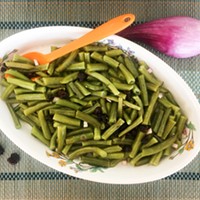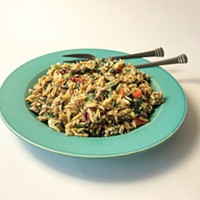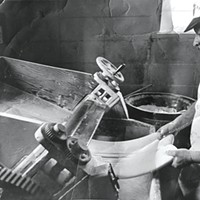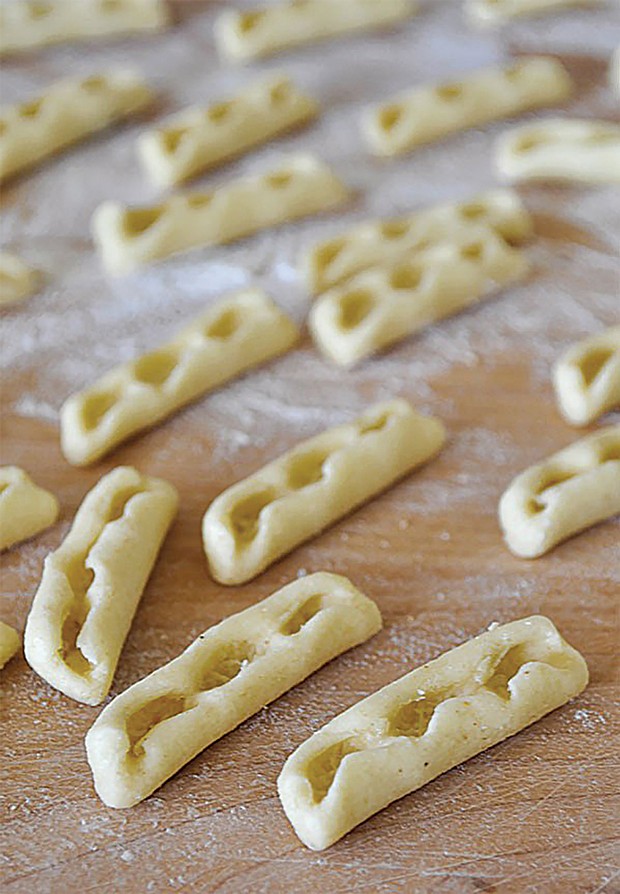[
{
"name": "Top Stories Video Pair",
"insertPoint": "7",
"component": "17087298",
"parentWrapperClass": "fdn-ads-inline-content-block",
"requiredCountToDisplay": "1"
}
]
Editor's note: The Journal's website is a treasure trove of recipes to explore while you shelter in place. This week we've plucked a Simona Carini's simple, three-ingredient homemade pasta from the stash (May 23, 2013), as comforting to eat as it is meditative to make.
In the beginning there is flour and water. Make the flour semolina flour (ground durum wheat) and make the water warm. The pale yellow semolina flour may look as if out of an impressionist painting, bathed in early morning sunlight.
In the first act of the performance, you make the dough. With a fork, you spread the somewhat recalcitrant water through the flour. When there is no more free water, the fork exits and your fingers come on stage. Your fingertips mix the wet and dry semolina. At first, it feels like there is not enough water but, squeezing the crumbly mix, the dough comes together. The graininess persists but, as you knead — pushing the dough away with the heels of your hands and gathering it back toward you in a soothing rhythm — the dough becomes smooth. It is not a soft dough but one with a strong personality, prime material for shaping pasta.
In about 10 minutes, when the dough feels smooth and firm, and the graininess is a distant memory, it is time to wrap the dough and let it relax. What happens next depends on your planned menu. The modest appearance of this dough belies its enormous potential.
The Encyclopedia of Pasta by Oretta Zanini De Vita contains entries for 310 types of pasta. The same pasta shape can have different names in different regions, or even different towns. Traditional shapes were taught by one generation to the next, so the recipes tend to have strong family roots. There is a bit of space, though, for my "rootless" interpretation — and for yours. Instead of a mother, grandmother or mother-in-law, I consult recipes and sometimes online videos, and I usually add a personal touch.
My adventure in the land of eggless pasta started with strascinati, made by shaping the dough into small cylinders, then dragging each one on the kneading board while pressing with your fingers. The movement thins the dough and gives it the shape of a cylindrical shell that shows the imprint of the shaping fingers in its cavity.
Shaping pasta by hand is patient work but, if you focus on each small piece of dough as if it were the only thing that matters in the moment, if you fully inhabit the sequence of gestures, then the process becomes a meditation of sorts. Each piece of pasta comes out a little different, personalized, unique.
With so many types of handmade pasta catalogued, not to mention the variations produced by using alternative types of flour, like chestnut flour or grano arso (burnt wheat) flour, I see myself in happy exploration mode for the foreseeable future.
If your fingers are craving some creative exercise, below is a recipe for strascinati that, in line with my philosophy of starting small, makes a manageable amount of dough. You can find links to both the dough making and shaping of the pasta online at www.northcoastjournal.com.
Handmade Strascinati
For the version I make (there are many in Italy), I use three fingers to shape the dough. Makes two small portions as an Italian first course.
Ingredients:
3 ½ ounces semolina flour
1 ¾ ounces warm water
A pinch of salt
Work the water into the flour and knead the dough until it is smooth and firm, about 10 minutes. Wrap the dough in plastic wrap, and let it rest for 30 minutes or so.
Prepare a work surface, such as a wooden cutting board or clean counter, by lightly dusting it with flour. You'll need room to shape dough and set aside the finished pasta.
Shape the dough into a thick roll, then cut it into five to six pieces. Take one piece (rewrapping the others) and roll it against the surface to form a rope about 3/8 inch in diameter. Cut each rope of pasta into segments about 1 ¼ inch long. Drag the dough toward you, pressing with your index, middle and ring fingers along the length of each segment. This movement thins the dough and gives it the shape of a cylindrical shell (about 1 ½ inches long). Depending on how you move your hands, you will get strascinati that are the same width as the original cylinder of dough and have a narrow opening, ones that are wider and more open, or something in between. All are fine.
Lay the shaped pasta out on the flour-dusted surface. Repeat with the rest of the dough, one segment at a time.
Once your pasta shapes are finished, boil them in salted water until tender when tasted — about 3 minutes, until they float to the top — and drain. Serve with the sauce of your choice.
Simona Carini also writes about her adventures in the kitchen on her blog www.pulcetta.com. She prefers she/her pronouns.
Speaking of...
-

Green or Purple, They All Snap
Aug 20, 2020 -

Entertaining for the Hesitant Host
Mar 12, 2020 -

Gone After Dinner
Jan 9, 2020 - More »
more from the author
-
A Green Dish for Earth Day or Any Day
- Apr 18, 2024
-
Spreading Vegetable Joy
Beets for a colorful vegan starter
- Jan 18, 2024
-
A Daily Dose of Awe
- Jan 4, 2024
- More »
































